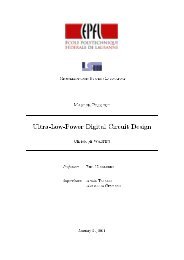Compressive Sensing system for recording of ECoG signals in-vivo
Compressive Sensing system for recording of ECoG signals in-vivo
Compressive Sensing system for recording of ECoG signals in-vivo
You also want an ePaper? Increase the reach of your titles
YUMPU automatically turns print PDFs into web optimized ePapers that Google loves.
Appendix CC.1. Analog ImplementationThere is a large range <strong>of</strong> applications <strong>in</strong> which random generation is necessary <strong>in</strong> order to beused <strong>in</strong> signal process<strong>in</strong>g blocks. Radi<strong>of</strong>requency communications signal mix<strong>in</strong>g, test <strong>system</strong>sand more recently biosignal compression based on CS are the most relevant ones. By means <strong>of</strong>an analog implementation <strong>of</strong> such randomness, a true random generation is achieved at theexpense <strong>of</strong> a larger circuit complexity <strong>of</strong> the <strong>in</strong>tegration <strong>of</strong> more exotic circuitry. The ma<strong>in</strong>techniques have been developed are: direct amplification <strong>of</strong> noise, high-frequency oscillatorsampl<strong>in</strong>g and randomness generation based on chaotic <strong>system</strong>s, and they are described below.C.1.1. Direct Amplification <strong>of</strong> NoiseThis method uses a device noise to make a decision <strong>of</strong> a bit 1 or 0 depend<strong>in</strong>g if the signal isgreater than certa<strong>in</strong> threshold or vice versa. This can be done by amplify<strong>in</strong>g the white noise <strong>of</strong> aresistor and then us<strong>in</strong>g a comparator to obta<strong>in</strong> a random bit. These schemes need a high-ga<strong>in</strong>bandwidthlow-<strong>of</strong>fset amplifier due to the fact that if a low-bandwidth amplifier is used, theoutput noise spectrum can be concentrated around DC and so, noise samples are correlated.Thus, they are not suitable <strong>for</strong> Radio Frequency Identification, RFID, <strong>system</strong>s. Animplementation has been presented <strong>in</strong> [29], and the ma<strong>in</strong> architecture is shown <strong>in</strong> Fig.C.1.1.1.This approach is not feasible to an on-chip application, due to area constra<strong>in</strong>ts.Figure C.1.1.1. Random generator based on direct amplification <strong>of</strong> noise [29].C.1.2. High-Frequency Oscillator Sampl<strong>in</strong>g [29]A TRNG can be implemented by comb<strong>in</strong><strong>in</strong>g a low-frequency jitter clock and us<strong>in</strong>g it to sample ahigh-frequency oscillator. The tim<strong>in</strong>g jitter is a stochastic phenomenon caused y thermal noisepresent <strong>in</strong> the transistors <strong>of</strong> a r<strong>in</strong>g oscillator. The drawback <strong>of</strong> this procedure is that themegahertz generation is power hungry, so it is not an option <strong>for</strong> an on-chip CS design.81















